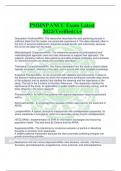PMHNP ANCC Exam Latest
2022(Verified)A+
Descriptive VividnessANS= The researcher describes the data gathering process in
sufficient detail that the reader can personally experience it. The data collected, often in
the form of personal statements, should be quoted directly and extensively, because
this is the raw data from the study.
Methodological CongruenceANS= The researcher presents the philosophical and
methodological approach used and cites references to support their approach. The
subjects, sampling method, data-gathering and data-analysis strategies, and processes
for informed consent are clearly and concisely described.
Theoretical ConectednessANS= Any theory developed from the study is clearly stated,
logically consistent, reflective of the data, and in accord with other available knowledge.
Analytical PrecisionANS= Is not concerned with statistics and instruments. If refers to
the decision-making process by which the researchers synthesize concrete data (words
of the subjects) into an abstract that clarifies the meaning and the importance of the
study. The last of the 5 criteria is Heuristic Relevance - The researcher clarifies the
significance of the study, its applicability to public health or community nursing, and its
likely influence o the future research.
PhenelzineANS= An MAOI that patients with atypical depression respond particularly
well to.
AtomoxetineANS= A norepinephrine reuptake inhibitor approved for the treatment of
ADHD.
LoxapineANS= A typical, tetracyclic antipsychotic with antidepressant properties. Its
active metabolite is amoxapine, which is a secondary amine tricyclic antidepressant.
HITECHANS= Implementation of EHR for information exchanges and improving
population health. This was done by Obama and the ARRA.
SuppressionANS= The intentional or conscious exclusion of painful or disturbing
thoughts or emotions from awareness.
A healthy defense mechanism because the client channels conflicting energies into
growth-promoting activities.
Medications that can induce depressionANS= beta blockers, steroids, interferon,
Accutane, benzodiazepines, progesterone, some antivirals, and antineoplasmics.
,Medications that can induce maniaANS= Steroids, Isoniazid, antidepressants (in
people who already have bipolar disorder), and Antabuse.
Medigap Insurance PoliciesANS= Private insurance policies purchased by elderly
individuals to cover some or all of their medical expenses not paid for by Medicare.
Medicare Advantage PlanANS= Formerly Medicare + Choice, this created regional
Preferred Provider Organizations (PPOs) and gave Medicare enrollees the option of
enrolling in private insurance plans.
Medicare + ChoiceANS= Was a part of the Balanced Budget Act of 1997 that
significantly increase the number of managed care insurance plans available to
recipients. This was replaced with the Medicare Advantage Plan in 200.
List of the Second Generation (atypical) Antipsychotics (9)ANS= Clozaril (clozapine),
Zyprexa (olanzapine), Latuda (lurasidone), ziprasidone, Risperdal (risperidone), Invega
Sustenna (palperidone), Fanapt (iloperidone), Seroquel (quetiapine), Saphris
(asenapine),
List of First Generation (typical) Antipsychotics (10)ANS= Haldol (haloperidol), Prolixin
(fluphenazine), Navane (thiothixene), Thorazine (chlorpromazine), Loxitane (loxapine),
Mellaril (thioridazine), Trilafon (perphenazine), Orap (pimozide), Solian amisulpride),
Stellazine (trifluoperazine)
List the 6 common benzodiazepines in order from shortest to longest half-lifeANS=
Xanax (alprazolam): 6-10 hrs
Serax (oxazepam): 8 hrs
Ativan (lorazepam): 12-18 hrs
Klonopin (clonazepam): 30-40 hrs
Valium (diazepam): 100 hrs
Librium (chlordiazepoxide): 36-200 hrs
List of SNRIs (6)ANS= Cymbalta (duloxetine), Pristiq (desvenlafaxine), Effexor
(venlafaxine), Fetzima (levomilnacipran), Savella (milnacipran), Strattera (atomoxetine)
Action of Tricyclic Antidepressants (TCAs)ANS= They target serotonin, norepinephrine,
and histamine-1 receptors
List the Tricyclic Antidepressants (9)ANS= Pamelor (nortriptyline), Elavil (amitriptyline),
amoxapine (no branded), Anafranil (clomipramine), Norpramin (desipramine), Tofranil
(imipramine), Vivactil (protriptyline), Sinequan/Silenor (doxepin), Surmontil
(trimipramine)
FINISH acronym for SSRI withdrawalANS= Flu-like symptoms
Irritability
Nausea
, Imbalance/instability/incoordination/dizzy (motor)
Sensory disturbances
Headache, hyperarousal (anxiety/agitation)
Signs of NMS (Neuroleptic Malignant Syndrome)ANS= Initial Symptoms: altered
sensorium, hyperreflexia, fever
Then signs of autonomic instability: extreme muscle rigidity, hypotension, tachycardia,
diaphoresis, tachypnea, hyperthermia, coma, death.
Check for increased WBCs (leukocytosis)/LFTs/CPK
Signs of Lithium toxicityANS= Confusion, diplopia, nausea/diarrhea, ataxia, lethargy,
fatigue, clumsiness, weakness, muscle cramping, severe tremor, blurred vision,
nystagmus, increased DTRs, altered mental status, cardiac dysrhythmias
Signs of Serotonin SnydromeANS= agitation, restlessness, rapid heart rate, blood
pressure elevation, headache, sweating, shivering, goose bumps, myoclonic jerking and
loss of coordination, confusion, fevers, unconsciousness, seizures
Medications that can increase lithium levelANS= NSAIDs, ACE Inhibitors (-prils), ARBs
(-sartans), tetracyclines, metronidazole
Medications that can decrease lithium levelANS= potassium-sparing diuretics, thiazide
diuretics, theophylline
Clozaril - monitoring considerationsANS= Monitor ANC (absolute neutrophil count); pt
needs an ANC of at least 1500 to start clozaril therapy; watch for Benign Ethnic
Neutropenia (BED); Monitor ANC weekly x6 months, every 2 weeks x6 months, then
monthly if ANC is at least 1500.
Substances that can cause a false + drug test for PCP & methadoneANS= Niquil, OTC
cough meds
Substances that can cause a false + drug test for heroin & morphineANS= rifampin,
fluoroquniolones
Substances that can cause a false + drug test for cocaineANS= NSAIDs, amoxicillin,
most antibiotics
Substances that can cause a false + drug test for amphetaminesANS= Prozac,
Wellbutrin, Trazodone, Nefazodone, Sudafed, OTC decongestants.
Schizophrenia Prevalence:
Non-twin siblings of a schizophrenic parent
Dizygotic twins of a schizophrenic parent
Monozygotic twins of a schizophrenic parentANS= 8%
12%




